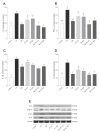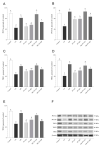Nicotinamide Riboside and Phycocyanin Oligopeptides Affect Stress Susceptibility in Chronic Corticosterone-Exposed Rats
- PMID: 37891928
- PMCID: PMC10604757
- DOI: 10.3390/antiox12101849
Nicotinamide Riboside and Phycocyanin Oligopeptides Affect Stress Susceptibility in Chronic Corticosterone-Exposed Rats
Abstract
Nicotinamide riboside (NR) is an NAD+ precursor capable of regulating mammalian cellular metabolism. Phycocyanin oligopeptide (PC), a phytonutrient found in blue-green algae, has antioxidant and anti-inflammatory properties. This study explored the effects of NR, PC, and their combination on the telomere length as well as inflammatory and antioxidant status of rats under chronic stress conditions (CS). Forty-nine rats were allocated into seven groups: control, chronic stress (CS), CS with NR (26.44 mg/kg), a low dose of 2.64 mg/kg of PC (PC-LD), or a high dose of 26.44 mg/kg PC (PC-HD), NR + PC-LD, and NR + PC-HF. The rats were given daily corticosterone injections (40 mg/kg) to induce stress conditions, or NR and PC were orally administered for 21 days. NR and PC supplementation, particularly NR plus PC, increased the serum antioxidant enzyme activities, hepatic nicotinamide adenine (NAD+) content, and telomere length (p < 0.001 for all) compared to the CS group. The levels of serum malondialdehyde (MDA), liver interleukin-6 (IL-6), tumor necrosis factor α (TNF-α), IL-1β, and IL-8 were reduced under the CS condition (p < 0.001). In addition, CS decreased the levels of hepatic telomere-related proteins and sirtuins (SIRT1 and 3), whereas administration of NR and PC or their combination to CS-exposed rats increased the levels of telomere-related proteins (e.g., POT1b, TRF1 and TRF2), SIRT3 and NAMPT (p < 0.05). In conclusion, NR and PC, especially their combination, can alleviate metabolic abnormalities by enhancing hepatic cytokines, SIRT3, NAMPT, and NAD+ levels in CS-exposed rats. More research is needed to further elucidate the potential health effects of the combination of NR and PC in humans.
Keywords: NAD; corticosterone; hepatic metabolism; nicotinamide riboside; phycocyanin.
Conflict of interest statement
James R. Komorowski, Sara Perez Ojalvo, and Sarah Sylla are employees of Nutrition 21 LLC (Harrison, NY, USA). The remaining authors declare no conflict of interest. The funders had no role in the design of the study; in the collection, analyses, or interpretation of the data; in the writing of the manuscript; or in the decision to publish the results.
Figures





Similar articles
-
Nicotinamide riboside does not alter mitochondrial respiration, content or morphology in skeletal muscle from obese and insulin-resistant men.J Physiol. 2020 Feb;598(4):731-754. doi: 10.1113/JP278752. Epub 2019 Dec 26. J Physiol. 2020. PMID: 31710095 Clinical Trial.
-
Axonal Protection by Nicotinamide Riboside via SIRT1-Autophagy Pathway in TNF-Induced Optic Nerve Degeneration.Mol Neurobiol. 2020 Dec;57(12):4952-4960. doi: 10.1007/s12035-020-02063-5. Epub 2020 Aug 20. Mol Neurobiol. 2020. PMID: 32820458 Free PMC article.
-
Nicotinamide riboside relieves the severity of experimental necrotizing enterocolitis by regulating endothelial function via eNOS deacetylation.Free Radic Biol Med. 2022 May 1;184:218-229. doi: 10.1016/j.freeradbiomed.2022.04.008. Epub 2022 Apr 14. Free Radic Biol Med. 2022. PMID: 35430341
-
NAD+ and NAFLD - caution, causality and careful optimism.J Physiol. 2022 Mar;600(5):1135-1154. doi: 10.1113/JP280908. Epub 2021 May 27. J Physiol. 2022. PMID: 33932956 Review.
-
NAD+ Precursors Nicotinamide Mononucleotide (NMN) and Nicotinamide Riboside (NR): Potential Dietary Contribution to Health.Curr Nutr Rep. 2023 Sep;12(3):445-464. doi: 10.1007/s13668-023-00475-y. Epub 2023 Jun 5. Curr Nutr Rep. 2023. PMID: 37273100 Free PMC article. Review.
Cited by
-
The role of nicotinamide adenine dinucleotide salvage enzymes in cardioprotection.Kardiochir Torakochirurgia Pol. 2024 Jun;21(2):86-95. doi: 10.5114/kitp.2024.141145. Epub 2024 Jun 30. Kardiochir Torakochirurgia Pol. 2024. PMID: 39055245 Free PMC article. Review.
References
-
- Hunter R.G., Seligsohn M., Rubin T.G., Griffiths B.B., Ozdemir Y., Pfaff D.W., Datson N.A., McEwen B.S. Stress and corticosteroids regulate rat hippocampal mitochondrial DNA gene expression via the glucocorticoid receptor. Proc. Natl. Acad. Sci. USA. 2016;113:9099–9104. doi: 10.1073/pnas.1602185113. - DOI - PMC - PubMed
-
- Burke S.J., Batdorf H.M., Huang T.Y., Jackson J.W., Jones K.A., Martin T.M., Rohli K.E., Karlstad M.D., Sparer T.E., Burk D.H., et al. One week of continuous corticosterone exposure impairs hepatic metabolic flexibility, promotes islet β-cell proliferation, and reduces physical activity in male C57BL/6 J mice. J. Steroid. Biochem. Mol. Biol. 2019;195:105468. doi: 10.1016/j.jsbmb.2019.105468. - DOI - PMC - PubMed
-
- Daiber A., Kröller Schön S., Oelze M., Hahad O., Li H., Schulz R., Steven S., Münzel T. Oxidative stress and inflammation contribute to traffic noise-induced vascular and cerebral dysfunction via uncoupling of nitric oxide synthases. Redox. Biol. 2020;34:101506. doi: 10.1016/j.redox.2020.101506. - DOI - PMC - PubMed
Grants and funding
LinkOut - more resources
Full Text Sources
Research Materials
Miscellaneous

